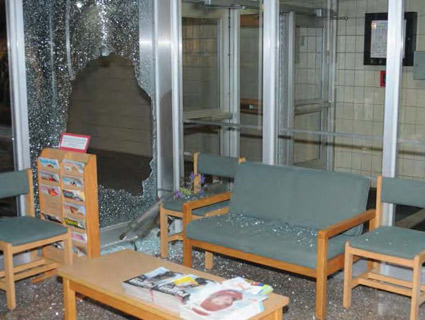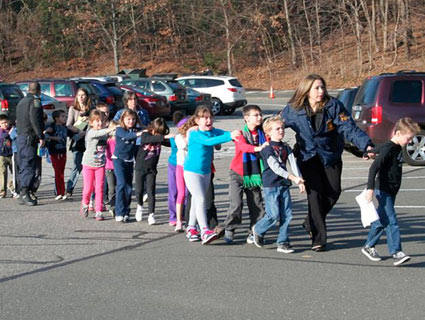
Entrance to Sandy Hook Elementary where Adam Lanza shot his way in. Connecticut State's Attorney Sandy Hook Crime Report
In the three months leading up to his rampage, Adam Lanza only communicated with his mother via email even though they lived in the same house. Prior to leaving on a short trip a few days before her son would murder her and head to Sandy Hook Elementary, Nancy Lanza cooked him some of his favorite dishes. Adam Lanza frequently spent his weekends at a local theater playing Dance Dance Revolution for up to 10 hours at a time. At the time of his death, the 6-foot tall Lanza weighed only 112 pounds. Those are among the new revelations from Connecticut State’s Attorney Stephen J. Sedensky’s final report on the Sandy Hook Elementary School massacre, which was released today.
The long-awaited official documentation of the December 14, 2012 massacre that left 20 children and six adults dead is only a summary of the yet-to-be released final crime report, which is estimated to run thousands of pages, according to the Hartford Courant. The summary report includes a timeline of the police response to Sandy Hook, starting with the first 911 call. It also offers some insight into the family history, interests, and mental health of the shooter, painting a dark picture of a deeply disturbed individual, but offering no conclusive motive for why he did it.
Included in the report is an inventory of video games he owned, along with a record of some of the evidence recovered from Lanza’s hard drives, such as images of him brandishing weapons, movies depicting mass shootings, and videos of people committing suicide by gunshot. Included in a separate appendix to the report are search warrants, photos of the crime scenes, and Lanza’s toxicology report (no drugs or alcohol were found in his system).
Sedensky has been criticized for delaying publication of the report and withholding 911 recordings, which are routinely released to the public. He is currently appealing a ruling by the state’s Freedom of Information Commission stating he must release the emergency calls. A judge is expected to listen to the tapes and make a ruling in the near future. With today’s release of the crime report, the investigation into the massacre is officially closed.
Here are some of the other key takeaways from the report:
- The first 911 call came in a 9:35 a.m., and the first Newtown police officer arrived onsite within four minutes of that call. Police didn’t enter the building, however, until six minutes later.
- The shooter had four guns with him at the school: a Bushmaster semi-automatic rifle which he used to murder 26 people at the school, a Glock 20 with which he took his own life, a Sig Sauer semi-automatic pistol which was found on his person but unfired, and an Izhmash Saiga 12-gauge semi-automatic shotgun which was left in the trunk of his car in the school parking lot. A fifth gun, a Savage Mark II rifle was recovered at the Lanza residence and was identified as the weapon used to kill his mother. All the guns were legally purchased by Nancy Lanza.
- When School Principal Dawn Hochsprung and school psychologist Mary Sherlach heard glass breaking, they ran out of a meeting in the school office into the hallway. Witnesses said they heard Hochsprung yell “Stay put!” Both women were gunned down.
- During the initial confusion at the scene, police arrested a number of people who were in the woods and around the school including two reporters who were held at gunpoint until they were identified.
- Lanza fired 50 rounds in one of the first grade classrooms, and over 80 in the other room he entered.
- GPS data showed that Lanza had driven near the school on the day before the shooting.
- Among the items recovered from the Lanza household were photocopies of newspaper clippings about shootings of school children dating back to 1891.
- Nancy Lanza had written a check to get her son Adam a new CZ 83 pistol. In the memo field she noted it was for Christmas.
- Lanza was noted to have a preoccupation with mass shootings, most notably Columbine.
- Lanza, who stood at 6 feet tall and weighed only 112 lbs at the time of his death, had an aversion to being touched.
- There was no evidence that Lanza had any strong connection to Sandy Hook Elementary School other than that he attended school there as a child.
- Witnesses’ memories of Lanza are very contradictory. Some describe him as having above-average intelligence and others as below average, some say he was bullied, while others—including teachers—saw nothing of the sort.
- Neither his older brother Ryan nor his father had seen Lanza since 2010.
- Lanza had a cell phone but never used it. All calls went to voicemail. His father communicated with him through email.
- He was very particular about food and its arrangement on the plate in relation to other food items.
- Lanza and his mother both took National Rifle Association (NRA) safety courses.
- Lanza was fond of video games, both violent and non-violent.
- He was so obsessed with the game Dance Dance Revolution that he was known to drive to the local theater on weekend nights and play the game for four to 10 hours.
- In fifth grade he wrote a series of stories called the “Big Book Of Granny,” in which the main character shoots children with a gun in her cane.
- Law enforcement officers and the teachers at Sandy Hook Elementary were commended for their actions in trying to protect the children and were credited with saving lives.
Read the full report here.











